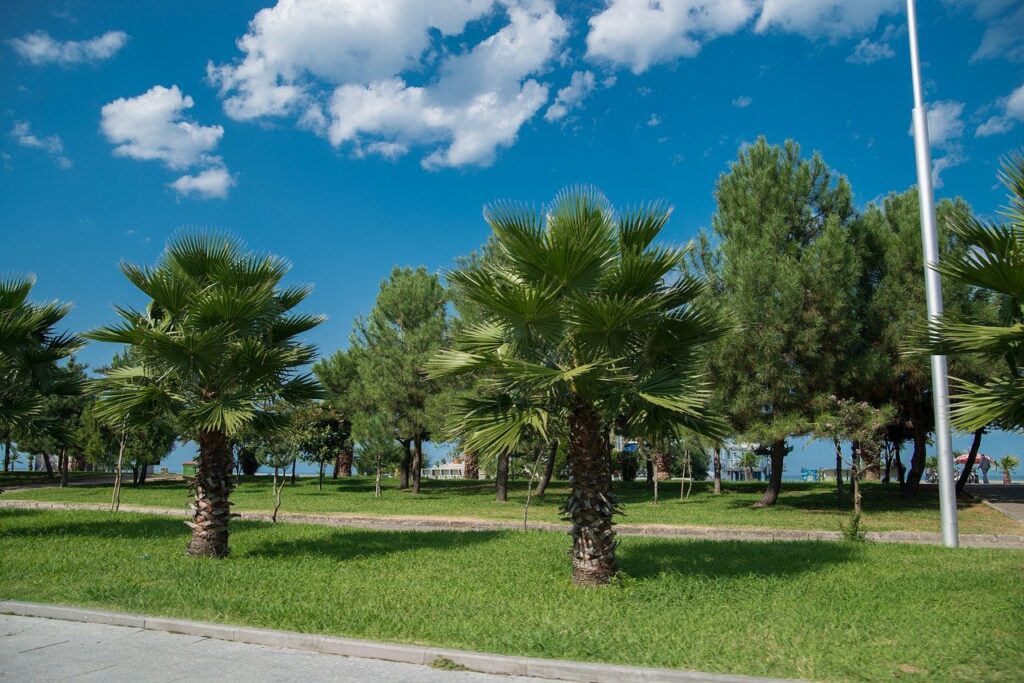Table of Contents
Georgia State Palm Trees
Even though Georgia state is not as warm as Florida, cold hardy palm trees will grow there. Georgia has a humid subtropical climate with hot summers and mild winters, and the Atlantic Ocean strongly influences its weather.
The average temperature in January is 39 °F (4 °C), and the average temperature in July is 78 °F (26 °C). The highest temperature ever recorded was 112 °F (44 °C), and lowest was −17 °F (−27 °C).
Winter is usually dry, and summer is hot and humid with occasional thunderstorms. The state does get tornadoes and tropical storms. The areas on the border with Florida experiences the most subtropical weather. Georgia USDA hardiness zones range from 6a to 9a.

They are indigenous to the tropical areas, and it could be odd that they grow naturally throughout Georgia. They were introduced in the past and had been flourishing since then.
A few species of palms found in Georgia and the Atlanta region include the sabal palm needle palm; windmill palm saw palmetto, the true date palm Canary Island date palm and the pindo palm. The majority of these palms can withstand the harsh winters typical in Georgia.
Do you know if there are palm trees growing within Georgia?
There are a variety of palm trees that grow in Georgia even though they aren’t native to the state. As a USDA Zone 7-8, Georgia experiences mild winters and hot summers during which certain varieties of palmettos and palm trees grow and flourish.
The humid subtropical climate prevalent throughout the state allows palms to thrive here if they are given proper maintenance and good soil drainage. However, most palms in Georgia don’t grow as tall as those found in Florida, which has far more appropriate climates for these trees to flourish.
What palm trees grow in Georgia?
If you’re driving along with one of Georgia’s most popular roads, there are palm trees along the streets for great visual appeal. This means that these trees could be planted in your backyard but only with proper care.
Although palm trees in indoor environments are simple to take care of and can be planted anywhere, outdoor conditions can be challenging to manage. So, it is important to choose between cold-hardy palms which thrive in different USDA zones for hardiness to grow effectively.
Growing Palm Trees in Georgia
Because there aren’t many areas within zone 9, it is recommended to choose palms that are cold-hardy and can withstand cold temperatures in zones between 7-8. There are a few palms that thrive in zones 6 – and down. Saw Palmetto Palm Tree is, in fact, native to Georgia. This hardy and cold-tolerant palm is tolerant to cold as low as 0F. It’s possible to cultivate Saw Palmetto Palm if you reside in zone 7a or higher.
- California Fan Palm Tree – Zones 8b -11 (15 to 20 F)
- Canary Island Date Palm Tree – Zones 8b -11 (15 to 20 F)
- Chinese Fan Palm Tree – Zones 8a – 11 (10 to 15 F)
- True Date Palm Tree – Zones 8b -11 (15 to 20 F)
- European Fan Palm Tree – Zones 7b – 11 (5 to 10 F)
- Mexican Fan Palm Tree – Zones 8b -11 (15 to 20 F)
- Queen Palm Tree – Zones 8b -11 (15 to 20 F)
- Saw Palmetto Palm Tree – Zones 7a -11 (0 to 5 F)
- Silver Saw Palmetto Palm Tree – Zones 7a – 11 (0 to 5 F)
Cabbage Palm (Sabal palm)
The sabal palm is, also known as the cabbage palm tree, is indigenous to Georgia and can be observed flourishing and growing in streets, homes and tropical gardens. It is part of the Arecaceae family and is one of the 15 varieties of the palmetto.
The cabbage palms of Georgia produce curved leaves around 3-4 feet in length that seem like they are fan-shaped. The flower heads extend beyond the canopy of leaves and produce a variety of tiny, creamy white sweet flowers, known for their ability to draw flowers.
As winter-hardy plants, the sabal palms found in Georgia typically do not reach 90 feet, but it is typical to see ones that measure between 40 and 50 feet high when growing standing up
Windmill palm
The windmill palm is among the cold-resistant palms you can find in Georgia. Georgia. It can survive frigid weather up to 10 degrees F. or less. While it is native to China, it can grow and flourish in Georgia and is located in the street corners of Atlanta.
The Windmill palm can reach as high as 40 feet but is typically regarded as a smaller one between 10 and 20 feet. In addition, the tree’s roots aren’t too deep, so you can plant them in your backyard.
Take note that some commonly-spread ailments of palms that affect palms at windmills include the deadly browning, root rot leaves spots, and root rot. It is worth considering these when planting the tree at your Georgia home.
The Needle Palm
It is yet another commonly found tree in Georgia. It is indigenous to the south Atlantic state within the United States, including Georgia, North and South Carolina, and North and South Carolina.
- USDA Zone of Hardiness 5b (-15 to 10 F) from 11 (above 40 F)
- Sunlight – from partial shadow to total sun
It is exceptionally robust and can withstand frigid temperatures that drop to 15F. It is suggested for USDA zones 5b-11 to plant it in Georgia with success.
It is among the palms with shorter length trees found in Georgia and other states in South Atlantic. If you’re not keen to plant the saw palmetto, then you could consider the needle palm since they share some resemblance, but the majority of people think it’s more attractive.
Saw palmetto (Serenoa repens)
The saw palmetto tree is native to Florida and other states in the southeast. It can be found in certain areas of Georgia, and, unlike other tall trees, it has a clumping pattern of growth which means it needs frequent pruning to keep its form.
There are many pine trees on the highways in south Georgia. Just below them are saw palmettos in clusters.
- USDA zones of hardiness 8-10
- Fantastic in full sun.
- Tolerant to drought once established
Saw palmettos prefer to be in full sunlight. However, you can plant them in all lighting conditions, and they will grow slowly and be only 2-7 feet.
Dwarf palmetto (Sabal minor)
It is indigenous to the southeast United States, from the Carolinas south to Florida and west up to Texas. It is commonly used on golf courses and other commercial landscaping projects in Georgia as a plant that can reach 5-10 feet high.
The palmetto is also referred to as its Spanish name, Sabal minor. It is extremely robust to cold and frost among tall palm trees of North American origin.
The suggested USDA zones of hardiness for the dwarf palmetto is USDA zones 7-10. Therefore, it can grow and withstand the cold winter temperatures of as low as 14 degrees, typical in Georgia perfectly.
Dwarf palmetto is a low maintenance palm tree utilized for fencing; however, you can also plant attractively in your yard with very little maintenance.
Mediterranean Fan Palm
The fan palm of the Mediterranean is another wonderful palm tree in Georgia that is known for its rapid growth rate with numerous trunks.
Also called Chamaerops Humilis scientifically, the Chamaerops humilis palm is also known scientifically as HTML1 andis an extremely cold-resistant palm tree that can withstand temperatures of up to 10°C. Because this plant grows at a rather rapid pace that is 12 inches annually, it is ideal for landscapes that are being developed and are often found in certain regions in Georgia and Texas.
True Date Palm Tree
The real Date palm may also be known by the name Phoenix Dactylifera. It has been known to expand and thrive in Georgia, Arizona, Alabama, Louisiana, etc.
While it’s an evergreen date palm, I wouldn’t advise you to plant it in your garden since it can grow to heights over 50 feet. It is massive and could easily overtake the other plants in your yard.
- USDA hardiness zone 8b (15 to 20 F) to 11 (above 40 F).
- Winter tolerance As as low as 15F
Although this tree can withstand the heat, it can’t perform well in high humidity places. This is why it’s not as common in Florida because it’s located on the state highways of Georgia.
Canary Island Date Palm Tree
Canary date palm Canary date palm blooms as a tree that is native to the Canary Islands. It can reach as high as 40-50 feet. Therefore, it’s not ideal for your garden since it can outdo other trees surrounding it.
But, the island of Canary date palm is among the palm trees that grow slowest, although it is not as slow as coco de mer palm.
The Island date palm can be used in USDA hardiness zones 9A-11 (> 20 degrees F) and is among the most common palm trees in Georgia. It is also found in Southern Carolina, Florida, Mississippi, Alabama, Lower Texas and Louisiana.
Queen Palm Tree
It is considered one of the most sought-after species of trees found in Georgia. It can grow to 40 feet in height and spread around 20 to 30 feet wide. They’re dense, slow-growing, but beautiful thanks to their deep green foliage and thick trunk.
Queen’s palms cannot naturally flourish in USDA zone 6, as they prefer warmer temperatures; however, you can plant ones inside USDA zones seven to ten.
If you are located near the ocean and are looking for a tree that can provide shade and provide your yard with an exotic appearance, this is the tree you’re looking for. They are a popular tree on islands since they can make excellent windbreaks, too.
Atlanta Palm Trees
The most popular palm trees that grow in Atlanta, Georgia, are:
- The windmill palm tree.
- The piano palm.
- The European fan palm tree.
- The Chinese fan palm.
Because Atlanta is located in USDA zones of 7b and 8a, trees can withstand 5 to 15 degrees Fahrenheit cold winter temperatures.
It is possible to plant the smaller varieties of palm trees within the Atlanta area, but make sure to provide them with the appropriate treatment and maintenance. What Is Blue Palm Tree
In what part of Georgia are palm trees?
Many people believe that palm trees are only found within tropical environments. But there are certain palms throughout Georgia! Georgia! The most popular type is known as the cabbage-palm (Sabal palmetto).
They can be found among these tall and sturdy plant species on islands around the coast or in wetlands further inland in Georgia. They thrive when there’s freshwater to drink as well as plenty of sunshine to soak up throughout the day.
A few of the palm trees found in the Zones 8b-11 of Georgia comprise Phoenix canariensis Canary Island date palm (Phoenix canariensis) and the Medjool Date Palm (Phoenix dactylifera), and Mexican fan palm.
In USDA zones 8a to 11 (10 up to 15 F) In USDA zones 8a – 11 (10 to 15 F), you can discover palm trees like those of Phoenix canariensis, Canary Island date palm (Phoenix canariensis), the Medjool Date Palm (Phoenix Dactylifera) and Mexican fan palm (Washingtonia robusta).
Conclusion
Georgia is located north of Tennessee, north by Alabama, and south by Florida. It’s not surprising to see palm trees in Florida; however, to the delight of many, Georgia includes palm trees.
The palm trees of Georgia are commonplace; however, their source is not. Georgia has been the home of palm trees for long periods.
No matter if you’re admiring the palms that tower over the roads of Savannah or spending a day at the Atlantic Ocean on Tybee Island, There’s no doubt the fact that these trees are beautiful and charming, in addition to shading from Georgia’s scorching heat.


